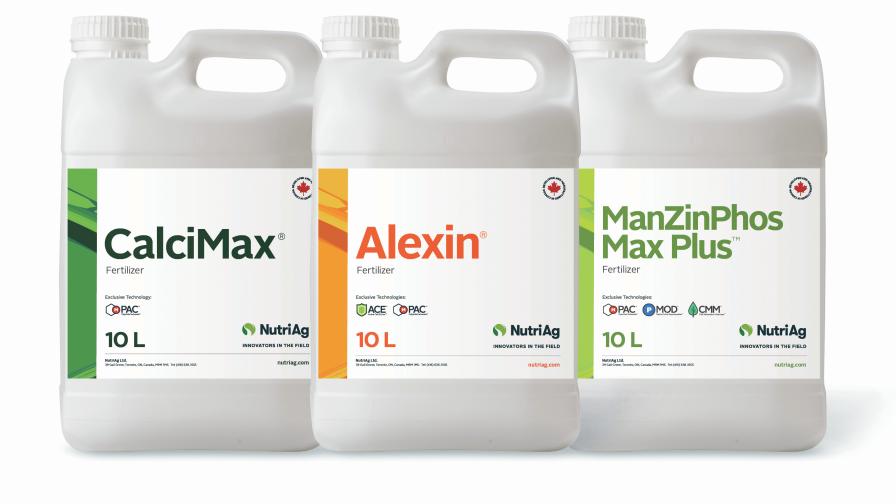Micronutrients Shine in 2020

Science, education, and a positive ROI have micronutrient use increasing in markets around the world.
Bright spots in 2020 have been few are far between. Micronutrients have proven to be one of those rare happy moments.
According to MarketsandMarkets research, the global agricultural micronutrients market is estimated to be valued at $3.6 billion in 2020 and is projected to reach a value of $5.4 billion by 2025.
“While this is just a projection, it provides an idea of the market potential,” says Brad Griffith, Chief Commercial Officer at Compass Minerals. “Plant nutrition as a category has been underappreciated and underrepresented in terms of science and data supporting the efficacy of its products.”
2020 Expectations
Part of that growth may come from a change in attitude about the need for micronutrients.
“The industry is vibrant,” says Dale Edgington, Purchasing and Production Manager for Advanced Micronutrient Products and Chairperson of the Micronutrient Association, which is now part of The Fertilizer Institute. “What once was considered a luxury, is now considered a necessity.”
It’s a necessity that has The Andersons planning for continued growth in the segment.
“The micronutrient product category continues to show steady growth each year as growers learn more and more about how various micronutrients contribute to their overall success of growing a crop, says Tony Donoho, Director of Sales, Specialty Nutrients, for The Andersons.
Compass Minerals expects to see growth as well.
“I expect the market to be up significantly,” Griffith says. “With prevent plant taking out 19 million acres last year, soil and crops are now getting the nutrients they need. We also continue to experience a retailer and grower community that is quite educated on the overall benefit of micronutrients and the value they can bring. As part of that evolution, growers continue to be conservative about how new products fit on the farm, with proven technologies like zinc on corn being more broadly accepted than newer formulations that they have limited experience with.”
Of course, with all technology growers want to know what they’re getting for their efforts.
“While this may slow initial product adoption, growers are willing to invest in products that show a consistent ROI advantage,” Griffith says. “Increasingly, growers are adopting advanced precision agriculture equipment that can help leverage the benefits of micronutrients by targeting the 4Rs — right source, right place, right rate, and right time.”
Despite the positive response to micronutrients for the 2020 growing season, not everyone was convinced this year would be special.
“Initially, there was concern that depressed farm commodity pricing would create enough economic uncertainty to reduce domestic demand for micronutrients,” Edgington says. “But reports that the U.S. and China had reached a Phase One trade deal in January that included targeted increases in commodity purchases provided impetus to stabilize demand for micronutrients. This was followed by the news that the coronavirus was affecting production and shipment of competitive micronutrient products out of China. The results where increased inquiries into domestic sources of production.”
Edgington agrees the Phase One deal was one important reason for the positive micronutrient market, but certainly not the only one.
“While farm commodity prices were not at a level to provide acceptable cash flow to many growers, the USDA Market Facilitation Program payments appear to have added enough liquidity to the market to cause farmers to follow best agronomic practices,” Edgington says. “The Phase One trade deal mentioned earlier increased expectation of demand for commodities and moved some acres from corn to soybeans. Drier soils in the Midwest in the early spring of 2020 allowed farmers to plant earlier, increasing yield potential and expected nutrient removal from the soil.”
Couple that with increased awareness and understanding and the season’s micronutrient outlook is positive.
“As the micronutrient space has grown in recent years, many producers have more awareness of micronutrient deficiencies in their crop and are turning to micronutrient fertilizers,” says Jake Socherman, Vice President of Sales, Verdesian Specialty Micronutrients. “We see a lot of opportunity here for enhanced production on the untreated row crop acre — with over 50% of acres in the U.S. currently not receiving treatment with a soil applied micronutrient.”
“We are very optimistic about this 2020 crop,” Socherman continues. “This year has exceeded our expectations from a business standpoint, amid challenging times for the industry.”
Companies have also added to their offerings allowing growers even more tailored solutions.
“This year’s expectations included the launch of a series of new micronutrient products which included fertilizer coatings, soil applications and bio nutritionals,” says Antony Hand, Chief Revenue Office, NutriAg. “The season started in uncertainty however growing conditions have generally been favorable across most of North America. We have seen increased understanding of the benefits of foliar application of micronutrients and the differentiation of technology from the inefficient suspensions and use of chelates that are poorly taken up by the plants.
“Solid science and data-based information on the value of foliar micronutrients, which are a key part of our portfolio has led to much wider adoption and growth,” Hand says. “Overcoming the perception of these products created by adoption of unsuitable technologies has helped drive further growth.”
Changing Trends
“Historically, the bulk of research and development funding in agriculture has been in seed genetics and biotechnology, crop protection products, biologicals, and precision application technologies,” Griffith says. “Many companies, including Compass Minerals, are now investing more to provide data-driven recommendations regarding nutrient formulations. Specifically, those that feed genetics and maximize the total crop input system farmers invest in.”
That is by no means the only change the micronutrient industry has seen.
“There is renewed interest in the starter fertilizer effect for P plus micronutrients,” Edgington says. “As planters grow larger though, it is difficult to carry enough material to supply high application rates. Therefore, in furrow, pop-up applications have focused on applying low rates of fertilizer to get the plant out of the ground which has increased demand for low-salt starters with chelated micronutrients. Balanced fertility programs then focus on blended, broadcast and banded applications of the rest of the nutrition.
“In this situation, every dealer is looking for a combination of products that allows them to maximize the throughput of their blend plant while providing a return on investment for the grower,” he continues. “This has led some manufacturers to use equipment programs to entice the purchase of a particular class of micronutrients including concentrated liquids and powders. Many dealers have focused on increasing the utilization of precision application with nutrient prescriptions blended on the go in the field. Multi-bin applicators utilize a combination of N, P, K and micronutrient products to meet the varying needs of crops and soils on a foot by foot, field by field basis.”
Like so many areas of change in agriculture, the technology has advanced well beyond where it was even just a few years ago.
“We are seeing more and more retailers and growers using a fully-loaded micronutrient pack with different tank mix partners such as herbicide and fungicides, thus allowing them to reduce the number of passes over the field,” Donoho says. “Depending on the product, most growers are running as much as a gallon per acre to a pint or quart per acre of several of our micronutrient products. The deficiency that the crop is either showing or has been discovered from a tissue test is driving the decisions that most retailers and growers are making.”
It’s all about getting the most out of what is being put down.

NutriAg combines nutrition with innovative technology to offer a wide range of micronutrient fertilizers.
“Technology is increasingly being used to optimize performance of inputs, and maximize micro and macro nutrient use efficiency,” Hand says. “NutriAg has invested heavily in our NutriAnalytics platform over the last decade which uses neural networking and artificial intelligence to develop algorithms that can analyze and predict responses to a wider range of variables in macro and micronutrient levels. This means that growers can maximize nutrient use efficiencies and the impact they have on each other in a way that has never been possible before. These result in optimized yield and predictable results from application of micronutrients and validates the performance of these inputs.”
Micronutrients are following along one of the other rapidly growing segments of agriculture.
“Precision agriculture technology has enabled us to be even more dialed in with nutrient prescriptions,” Socherman says. “While this has been ongoing with NPK for some time, the next stage is bringing micronutrients into the fold and delivering micronutrient concentrations more in line with crop removals. Premium products and a more targeted delivery are key for achieving Nutrient Use Efficiency.”
Regulatory
Whether in the U.S. or Europe, manufacturers always keep an eye on how products are being viewed by regulatory bodies.
“We generally haven’t seen a significant change, although there are a few notable exceptions,” Griffith says. “Regarding dicamba and 2,4-D tank mix approvals, it has definitely impacted micronutrients in the fact that they have to pass the EPA testing and review process for tank mix applications. Currently, there is uncertainty about how dicamba will continue to be evaluated by the EPA. The same uncertainty exists for biostimulants and how they will be registered — by the EPA or not. Beyond these specific instances regulatory considerations have been fairly consistent.”
As with most regulatory bodies the tendency is to become more restrictive.
“The regulatory environment on nutrient management has evolved toward controlling and directing the amounts of nutrients to closely follow specific crop demands,” Socherman says. “As with NPK, micronutrients, too, have been over-applied for many years due to the sources and forms of commercially available products.
As with traditional pesticides, Europe tends to mandate more control over micronutrients than other parts of the world.
“At this time, we are seeing some pressure on EDTA micronutrients, especially in Europe,” Donoho says. “We continue to monitor all the regulatory agencies to stay on top of any future regulations that may impact this product category.”
Important Markets
“From smallholder farms to commercial growers, we see opportunities on every continent,” Griffith says. “The Middle East, Southeast Asia, the Americas, and the European Union offer abundant nutritional opportunities. The Midwest row crop market and specialty crop markets here in the U.S. will remain paramount.
“The ban of certain pesticides in the EU has opened up the opportunity to offset potential yield loss by leveraging key micronutrient and biological technologies. On the whole, international markets continue to show promise for future growth,” Griffith says.
Europe and Asia show promise but is not without challenges.
“The market in European Union has a significant barrier to entry called REACH. It is expensive and time consuming to register there, and the market is mature,” Edgington says. “Demand exists for some homogenous NPK products that include micronutrients, but the majority of the market utilizes chelates to feed the crop utilizing multiple application trips throughout the growing season. There is ample demand in SE Asia but distributors there identify that it is difficult to get paid in a timely manner. Demand for NPK is robust in South America but the market for micronutrients seems to lag. Increased soil testing would undoubtedly uncover many hidden hungers for zinc, manganese, boron, and copper.
“Whether you believe in global warming or climate change or not, corn and soybean acres are creeping north in North America,” Edgington says. “Minnesota and the Dakota’s are growing more crops and achieving higher yields every year and demand in that region is growing with it. The market continues to extend into the prairie provinces of Canada. Africa has long been known to benefit from nutrient supplementation, but recurring drought has had such a negative impact on yield and cash flow that reducing moisture loss has taken first priority. Once soil conservation and moisture conservation practices are well in hand, demand is expected to grow exponentially in order to meet the domestic demand for food, fiber, feed and fuel.”
Basically, anywhere crops are grown, it seems has growth potential.
“While corn, soybean and wheat markets continue to be our core markets, we are exploring new opportunities in higher value crop market segments in North and South America,” Donoho says. “We see some real opportunities for growth in some South America countries and several areas in the United States that grow specialty crops.”
There is also opportunity for increasing micronutrient use in row crops.
“Specialty crop markets in coastal regions have been utilizing micronutrients for many years at increasing volumes, but the sheer acreage of planted corn and soybeans in the U.S. Corn Belt still presents the largest market opportunity, today,” Socherman says. “The U.S. row crop market continues to grow in its adoption, only encouraged by the introduction of new hybrids that require a complete nutritional program in order to achieve their full genetic potential. We also see significant opportunity in South American and European markets.”
Challenges
Despite the enthusiasm and increased use around micronutrients, there are still hurdles for the industry to overcome.
“Education, innovation and regulation can all be limiting,” Griffith says. “Educating farmers on the 4Rs has to be an industry focus. As the saying goes, ‘teach a man to fish.’ Innovation is both investment in the category as well as the protection of intellectual property. We have publicly stated our openness to working with other companies to combine our capabilities bringing innovation to the category faster and focusing on IP generation resulting from such endeavors. Finally, the regulation of micronutrients has been reasonable in most parts of the world. This encourages the development of yield-enhancing nutritionals to offset other crop inputs that may have been removed from the market.”
There are also concerns over supply.
“Raw materials are becoming more difficult to find,” Edgington says. “Zinc is recognized as an essential nutrient in human nutrition and is deficient in the soils, crops and diets of many in the world. The number of mines recovering zinc ore has declined and without significant investments in infrastructure, competing demands for metals, oxides, sulfates and chlorides are increasing the demand for recycled sources of the element. This will ultimately drive up the price.”
NutriAg’s Hand suggests another concern.
“Instability in crop demand and pricing is the biggest challenge,” he says. “Delivering a value equation that makes a compelling case for expanded micronutrient usage is not a simple concept when growers are more concerned about the what the market is for their crops, and how it will be impacted by global pandemics, and rapidly changing duty and tariff situations.”
“When there is already instability, human nature goes against adding another variable, and therefore the natural instinct is to not make changes and to maintain the status quo,” Hand says. “This is made even more complex with the inability to meet face to face, have grower meetings, show demonstrations and interact in conventional ways.”
And as always, a lack of understanding continues to keep some growers from taking advantage of the benefits of micronutrients.
“Education. We work to continually educate ourselves, retailers, and growers on the importance of micronutrients to produce high quality crops,” Donoho says. “While NPK is essential to the growth of a crop, having a balanced fertility program with the utilization and incorporation of micronutrients is key to a grower’s overall success. Farmgate profitability is another challenge to the growth of micronutrients. With today’s market conditions, growers may be focused on profit-maintaining rather than profit-adding, making it a bit more challenging for them to invest even more in their crop.”
An uncertain economy also lends itself to hesitation.
“The current economics in agriculture certainly offer some headwinds as farmers try to determine how to ‘do more with less,’” Socherman says. “The challenge lies in the mindset shift that a complete nutrient program, including micronutrients, is the key to maximizing the overall fertilizer investment.”
Opportunities
Every challenge, though, offers and opportunity.
“We see significant market potential in molybdenum and iron” Griffith says. “Regions with weathered soils, like Africa, require reliable inputs to manage these deficiencies. Another significant opportunity is how we can work together as a global agriculture community to improve crop management and crop fertility education across the world.”
Technology and learning more about the interplay between soil health, plants, and the environment will also help improve product use.
“The opportunities will come from modeling complex interactions between macro and micronutrients in the soil, crops, varieties, and growing conditions and using the models to tailor solutions that can deliver the optimal outcome,” Hand says.
When it comes to agriculture nothing is simple, but the more the products are understood, the more effective they’ll be.
“Easy- and ready-to-use micronutrient packages that contain the nutrients that are typically deficient within a grower’s region,” Donoho says. “We need to take the guesswork out of how and why a grower should use a micronutrient pack to help with overcoming nutrient deficiencies and overall growth of their crop.”
Socherman agrees.
“We believe a deeper understanding of micronutrients role as it relates to the soil and plant development will continue to take more priority along with pinpointing new technologies that assist in harnessing micronutrient efficiency,” he says.
Looking Ahead
“There is a huge untapped market of untreated acres that would make up the future growth of the industry,” Hand says. “There is growing understanding of the importance of micronutrients and this is leading to continued strong growth even in tough agronomic years such as last year. This year is very positive for the industry as a whole despite the current economic uncertainty.”
The weather is always a contributing factor.
“There are a number of areas in the U.S. and Canada that are showing the impact of low rainfall and high temperatures which may become critical in the coming weeks, and we are watching the situation carefully,” Hand says. “However, this also gives rise to opportunities where micronutrients can help with stress mitigation and maximize yield potential if the situation does not deteriorate completely.”
As the 2020 growing season starts to wind down, manufacturers look to 2021.
“As the this year’s crop finishes out, we anticipate seeing demand for micronutrients to drop off,” Donoho says. “The outlook for 2021 is favorable but the industry will need to see an uptick in commodity prices as a result of improved demand for corn and soybeans.”
As always, it comes down to profit.
“In times of low commodity prices, the only way to ensure a profitable crop is to out-yield the economics,” Socherman says. “One way to ensure maximum ROI on your fertilizer investment is by supporting it with a complete nutritional program, which includes micronutrients.”






